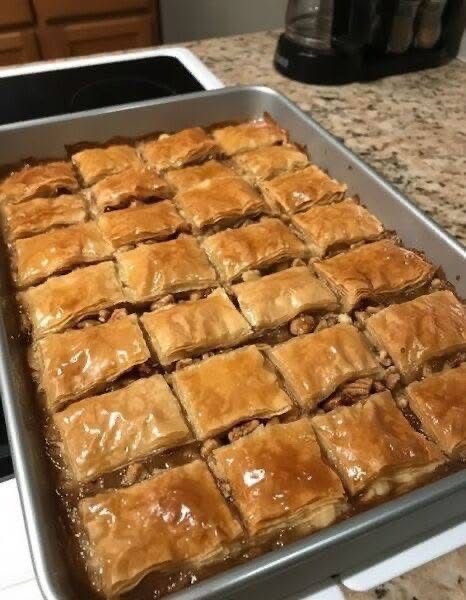
Introduction
Baklava is one of the most beloved desserts across the Middle East, Turkey, Greece, and beyond. It’s a luxurious pastry made of crispy layers of phyllo dough, filled with spiced nuts, and soaked in a fragrant honey syrup. Its origins go back thousands of years, believed to have been first made in the Assyrian Empire (around the 8th century BC). Over time, it spread across empires, becoming a traditional festive sweet.
Making baklava at home may seem intimidating, but with patience and the right steps, you can create this golden, crunchy, and syrupy delight that melts in your mouth.
Ingredients
For the Nut Filling:
- 3 cups mixed nuts (walnuts, pistachios, almonds, or pecans – your choice)
- 1/3 cup granulated sugar
- 2 teaspoons ground cinnamon
- 1/2 teaspoon ground cloves (optional, for depth of flavor)
For the Pastry:
- 1 package (16 oz) phyllo dough (thawed if frozen)
- 1 cup unsalted butter, melted (or more if needed)
For the Syrup:
- 1 cup water
- 1 cup granulated sugar
- 1 cup honey
- 2 tablespoons lemon juice
- 1 cinnamon stick
- 2–3 whole cloves (optional)
- 1 teaspoon orange blossom water or rose water (optional but traditional for aroma)
Instructions
Step 1: Prepare the Nut Filling
- Chop the nuts finely using a food processor or knife (not too powdery – you want texture).
- Mix nuts with sugar, cinnamon, and cloves in a bowl. Set aside.
Step 2: Prepare the Phyllo Dough
- Preheat oven to 350°F (175°C).
- Unroll the phyllo dough and cover it with a clean, damp towel so it doesn’t dry out while you work.
- Brush a 9×13 inch baking pan with melted butter.
Step 3: Layer the Baklava
- Place one sheet of phyllo in the pan, brush lightly with melted butter. Repeat until you have 8 layers.
- Sprinkle about 3–4 tablespoons of the nut mixture evenly on top.
- Add another 4–5 layers of phyllo, brushing each with butter, then another layer of nuts.
- Continue layering: alternating nuts and buttered phyllo, until nuts are finished.
- Finish with 10–12 buttered sheets on top.
Step 4: Cut Before Baking
- Using a sharp knife, cut the baklava into diamonds or squares (like in your picture) before baking. This helps it bake evenly and prevents crumbling later.
Step 5: Bake
- Bake for 50 minutes to 1 hour, until the pastry is golden brown and crisp.
Step 6: Make the Syrup
- While baklava is baking, combine water, sugar, honey, lemon juice, and spices in a saucepan.
- Bring to a boil, then reduce to simmer for 10 minutes until slightly thickened.
- Remove cinnamon stick and cloves, then stir in orange blossom or rose water if using. Let cool slightly.
Step 7: Soak the Baklava
- As soon as the baklava comes out of the oven, immediately pour the warm syrup evenly over it.
- Let it sit uncovered at room temperature for at least 6 hours or overnight so the syrup fully soaks in and the flavors develop.
Tips & Methods
- Crisp layers: Always brush phyllo with butter to prevent drying and ensure flakiness.
- Syrup timing: Hot baklava gets cool syrup OR cool baklava gets hot syrup. Never both hot, or it gets soggy.
- Storage: Store at room temperature, loosely covered, for up to 1 week. No need to refrigerate (unless you live in a hot climate).
- Variations: Use only pistachios (classic Turkish), walnuts (common Greek), or mix with hazelnuts and pecans.
Benefits
- Nutrient-rich nuts: High in protein, healthy fats, and minerals.
- Honey: Natural sweetener with antioxidants.
- Spices: Cinnamon and cloves add anti-inflammatory properties.
- Energy boost: A small piece provides lasting energy, perfect for celebrations.
Nutrition (per piece, approx. 1/24 of tray)
- Calories: 230
- Carbs: 25g
- Fat: 14g
- Protein: 3g
- Fiber: 2g
- Sugar: 14g
Conclusion
Baklava is not just a dessert – it’s a tradition, a celebration, and a piece of history wrapped in crispy golden layers. Making it at home fills your kitchen with the smell of toasted nuts, butter, and spiced honey. Serve it at family gatherings, special occasions, or just as a treat with tea or coffee.